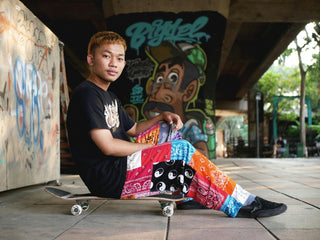Sustainable streetwear fashion isn't just a current trend; it's a movement with roots in counterculture. Emerging from the rebellious spirit of the '80s and '90s street scenes, contemporary sustainable streetwear now combines that rebellious edge with a conscientious mindset. As we explore this intersection of style and sustainability, our journey will unveil the historical echoes of streetwear and the modern resurgence of purpose-driven fashion.
The Rise of Sustainable Streetwear
Rooted in the rebellious urban cultures of the '80s and '90s, streetwear has always embodied a spirit of defiance. The sustainable streetwear movement builds upon this history, fusing New York's hip-hop fashion, California's surf-skate culture, and Japanese street fashion. Today, with influencers and musicians championing eco-friendly choices, the ethos of conscious consumerism in streetwear has evolved, demonstrating that style and sustainability can seamlessly coexist in the contemporary fashion landscape. The emergence of sustainable streetwear brands like Wawwa and Doodlage serves as a prime example, blending streetwear's historical rebelliousness with a commitment to ethical and sustainable practices, setting the stage for a new era in conscious street fashion.
Spike Lee's Cinematic Influence on Streetwear
Renowned filmmaker Spike Lee and costume designer Ruth E. Carter have not only left an indelible mark on cinema but have significantly shaped the world of streetwear fashion through his culturally rich and bold narratives.
In iconic films like "Do the Right Thing" and "She's Gotta Have It," Lee captures the vibrant essence of African-American street culture. The characters' styles, infused with eclectic patterns and cultural symbols, resonate with the grassroots origins of streetwear, influencing the visual language of urban fashion.

- Cultural Commentary through Fashion:
Lee's films delve into the heart of African-American experiences, capturing the pulse of urban life and the struggles faced by marginalized communities. This authenticity extends to the fashion portrayed in his movies. The characters' wardrobes not only contribute to the storytelling but also serve as a reflection of the socio-cultural landscape. The representation of streetwear in Lee's films is not just about style; it's a nuanced commentary on identity, community, and the resilience of urban fashion.
- The Roots:
Ruth Carter's costumes take us back to the roots of streetwear. From the DIY aesthetics of "Do the Right Thing" to the individualistic styles in "Malcolm X," his films encapsulate the authentic beginnings of streetwear. The streets become runways, showcasing diverse, genuine styles that contribute to the broader narrative of streetwear as a cultural movement rooted in urban expressions.
Sustainable Streetwear Brands
In the '80s, streetwear pioneers set the stage for today's sustainable revolution. Fast forward to the present, and brands like BastiBasti and Plant Faced Clothing seamlessly integrate historical streetwear aesthetics with sustainable practices. Closer to home, Indian sustainable streetwear brands like 11:11 draw inspiration from traditional craftsmanship, blending historical artistry with contemporary designs. This harmonious fusion exemplifies the transformative power of fashion across generations. As sustainable streetwear brands pave the way for a new era in street fashion, it becomes clear that sustainability is not just a trend but a fundamental shift in the industry's ethos.
Organic Fabrics in Streetwear
The use of organic fabrics in streetwear reflects a departure from the synthetic dominance of the past. From the rebellious days of graffiti-covered streets to the contemporary push for sustainability, the shift towards organic materials is a testament to the evolving conscience of streetwear. Embracing organic cotton and hemp isn't just about style; it's a nod to the historical ethos of streetwear, now redefined with an eco-friendly twist.
Fairtrade Practices in Streetwear
Fairtrade practices in streetwear echo the social justice movements that have marked various points in history. The concept of fair trade has evolved from grassroots activism to becoming an integral part of ethical streetwear. By supporting fairtrade, consumers contribute to a narrative that goes beyond fashion—embracing a legacy of equity that has its roots in historical struggles for workers' rights.
Inclusivity in Streetwear Fashion
Historically, streetwear has been a medium for self-expression and inclusivity, breaking away from traditional fashion norms. In contemporary sustainable streetwear, this spirit continues. Brands challenge stereotypes and embrace diversity, echoing the inclusivity that street culture has symbolized throughout history. From the streets to the runways, the message is clear: sustainable streetwear is for everyone.

Sustainable Streetwear in the Indian Fashion Scene
India's history of craftsmanship and textile artistry is the beating heart of its sustainable streetwear scene. From the traditional weaves of the past to the contemporary fusion of heritage and modernity, Indian designers are crafting a unique narrative. The resurgence of sustainable streetwear in India isn't just a fashion statement; it's a celebration of cultural history. As Indian designers reimagine traditional textiles for a global audience, they bridge the historical and contemporary aspects of sustainable fashion.
Conclusion
Sustainable streetwear is the future. QuirkyBae intends to show that style and sustainability can coexist. As eco-friendly practices become widespread, inclusivity, fairtrade, and organic choices become standard. The future of streetwear is not just a trend; it's a shift towards conscious and edgy fashion, setting the tone for a fashion industry that prioritizes sustainability.


